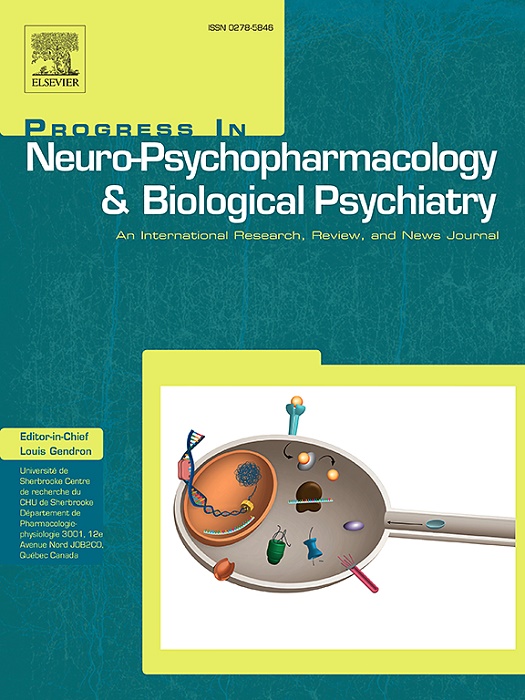Behavioral assessments and differential excitability, oscillatory dynamics in dorsal and ventral hippocampal CA1 neurons in male rats of a prenatal VPA-exposed autism model
IF 3.9
2区 医学
Q1 CLINICAL NEUROLOGY
Progress in Neuro-Psychopharmacology & Biological Psychiatry
Pub Date : 2025-10-02
DOI:10.1016/j.pnpbp.2025.111507
引用次数: 0
Abstract
The distinct electrophysiological properties of the dorsal (dHPC) and ventral (vHPC) hippocampus play crucial roles in cognitive and emotional processing. This study investigates the variations in firing activities between these hippocampal regions to develop targeted therapies for conditions such as autism. We conducted behavioral assessments and explored the properties of CA1 pyramidal neurons in the dHPC and vHPC using whole-cell patch-clamp recordings in a prenatal Valproic Acid (VPA)-exposed autistic-like model. Additionally, oscillatory activities in the dHPC and vHPC were analyzed through local field potential recordings across specific frequency bands during immobility in awake rats.
Our evaluation confirmed ASD-like phenotypes, including social deficits, repetitive behaviors, cognitive impairments, and emotional dysregulation. Significant differences in membrane properties and firing activities were revealed between the dHPC and vHPC regions, examining network alterations and intrinsic neuronal properties. Notably, autism induction increased excitability in dorsal CA1 neurons compared to ventral neurons in the autism-like group. Analysis of delta, theta, and gamma frequency bands showed distinct spectral power differences between control and autism-like groups exposed to VPA. Autistic-like rats exhibited higher delta and theta power, with a significant impact on gamma activity, specifically in the dHPC.
These findings provide novel insights into the behavioral and electrophysiological alterations in a prenatal VPA-exposed autistic-like model, emphasizing hippocampal hyperexcitability's role in ASD. The results underscore the complexity of anatomical and functional distinctions between the dHPC and vHPC, highlighting spectral dynamics and potential pathological alterations in oscillatory patterns under neuropsychiatric conditions.
产前vpa暴露自闭症模型雄性大鼠海马背侧和腹侧CA1神经元的行为评估和差异兴奋性、振荡动力学。
背侧海马(dHPC)和腹侧海马(vHPC)的电生理特性在认知和情绪加工中起着至关重要的作用。这项研究调查了这些海马区域之间放电活动的变化,以开发针对自闭症等疾病的靶向治疗方法。在产前丙戊酸(VPA)暴露的自闭症样模型中,我们使用全细胞膜片钳记录对dHPC和vHPC中CA1锥体神经元的特性进行了行为评估和探索。此外,在清醒大鼠静止状态下,通过特定频段的局部场电位记录,分析了dHPC和vHPC的振荡活动。我们的评估证实了asd样表型,包括社交缺陷、重复行为、认知障碍和情绪失调。在dHPC和vHPC区域之间发现了膜性质和放电活动的显著差异,检查了网络改变和内在神经元性质。值得注意的是,与自闭症样组的腹侧神经元相比,自闭症诱导增加了背侧CA1神经元的兴奋性。对δ、θ和γ频段的分析显示,暴露于VPA的对照组和自闭症样组之间存在明显的频谱功率差异。自闭症样大鼠表现出更高的δ和θ能量,对γ活动有显著影响,特别是在dHPC中。这些发现为产前暴露于vpa的自闭症样模型的行为和电生理改变提供了新的见解,强调了海马过度兴奋性在ASD中的作用。结果强调了dHPC和vHPC之间解剖和功能差异的复杂性,强调了神经精神疾病下振荡模式的频谱动力学和潜在病理改变。
本文章由计算机程序翻译,如有差异,请以英文原文为准。
求助全文
约1分钟内获得全文
求助全文
来源期刊
CiteScore
12.00
自引率
1.80%
发文量
153
审稿时长
56 days
期刊介绍:
Progress in Neuro-Psychopharmacology & Biological Psychiatry is an international and multidisciplinary journal which aims to ensure the rapid publication of authoritative reviews and research papers dealing with experimental and clinical aspects of neuro-psychopharmacology and biological psychiatry. Issues of the journal are regularly devoted wholly in or in part to a topical subject.
Progress in Neuro-Psychopharmacology & Biological Psychiatry does not publish work on the actions of biological extracts unless the pharmacological active molecular substrate and/or specific receptor binding properties of the extract compounds are elucidated.

 求助内容:
求助内容: 应助结果提醒方式:
应助结果提醒方式:


